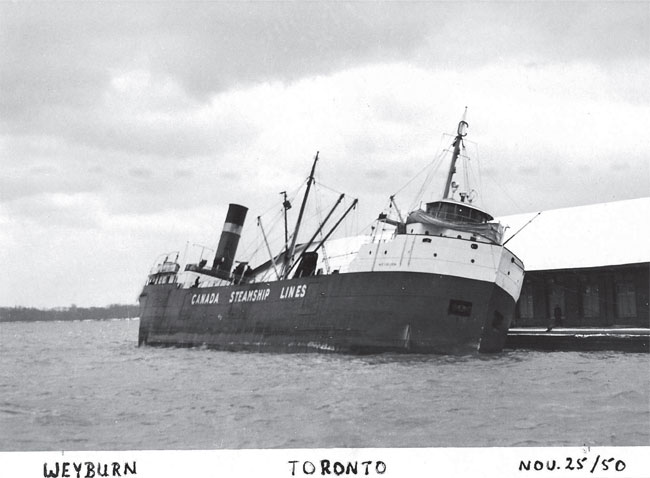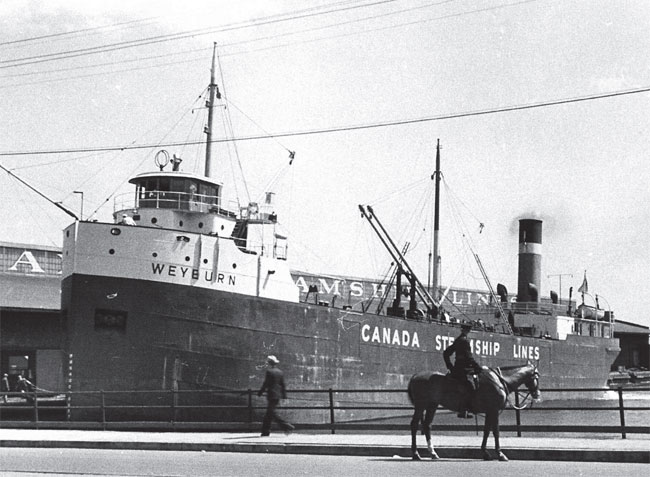Shipwreck: Weyburn
Skip Gillham Vineland, Ontario, Canada

This spring marked the 50th anniversary of the opening of the St. Lawrence Seaway. After decades of anticipation and years of construction, the new waterway connecting Lake Ontario with the St. Lawrence at Montreal was ready for commercial traffic.
Seven locks, enabling ships up to 730 feet long by 75 feet wide, replaced the old system of locks and channels that limited vessels to 261 feet long by 43 feet, at the beam. One of the new, modern lakers could now carry as much cargo through the system as ten of the small, old canal-sized ships.
The biggest ceremony on opening day, April 25, 1959, was held at the St. Lambert Lock at the eastern end of the Seaway as the small carrier Simcoe, followed by the Prescodoc, took the lead for the upbound trip to the Great Lakes. At the Iroquois Lock, at the western end, two more old canalsized freighters, the Humberdoc and Weyburn led the downbound traders.
Although the Weyburn was the second ship at Iroquois, it overtook the slower Humberdoc in no time and was soon the leader on the downbound side.
Weyburn had been built at the Georgian Bay community of Midland, Ontario, in 1927. It was part of an unusual triple launching ceremony on June 14, 1927, with a sistership, the Saskatoon and the tug Northshore Supply, sliding into the water the same day.
Weyburn entered service on August 9, 1927, and was designed for the package freight trade. It sailed for Canada Steamship Lines between their freight sheds and terminals scattered between the Canadian Lakehead and Montreal. Way stops, as required, might include Sault Ste. Marie, Sarnia, Windsor, Thorold, Hamilton, Toronto or Kingston. It is shown at Toronto, with a mounted police officer, in a photo by Alfred King.
The 261 foot long by 42 foot, 9 inch wide vessel was registered at 2,408 gross tons and able to carry in the range of 3,000 tons at full draft. The old canals limited the draft to 14 feet so Weyburn would not be loaded as deep as on the Great Lakes. A small triple expansion engine was steam powered with a pair of coal-fired scotch boilers.
As one of the newest vessel in the fleet, Weyburn continued fairly regular service during the Depression and was very active during World War Two. It handled a wide variety of packaged freight, usually loaded through side doors on pallets, or via deck mounted kingposts. Paper products, canned goods, machinery and even deckloads of new automobiles could be found on board.

While the Great Lakes is known for their famous storms, particularly the “Gales of November”, Lake Ontario is generally considered to be the calmest of the five inland seas. This was not the case on November 25, 1950, when the cargo of steel on board Weyburn shifted as a storm battered the west end of the lake. The vessel developed a serious list to port and was in danger of capsizing. Two other lakers, Renvoyle and Howard Hindman, stood by and eventually towed Weyburn to the safety of Toronto. There the cargo was unloaded and the ship is shown in a photo by John H. Bascom.
The opening of the Seaway in 1959 made ships the size of Weyburn redundant on the Great Lakes. Too small to be competitive in the old trades they once dominated, most of these ships were broken up for scrap. A few, such as Weyburn, got a reprieve and were sold for saltwater service.
Weyburn had operated throughout 1961 and then tied up at Kingston, Ontario, at the eastern end of Lake Ontario. The ship was sold in 1963 and left the Seaway it helped open flying the flag of Panama during November 1963. Its destination was Houston, TX where a cargo of grain was loaded aboard for delivery to Pakistan. The voyage proved to be a nightmare.
The engine broke down in an Atlantic storm and the freighter had to be towed to safety in Bermuda. The engine could not be repaired there so the vessel was then towed to Spanish Morocco. The work was completed and Weyburn, despite a brief mutiny, headed down the Mediterranean and through the Suez Canal under its own steam. After a stop at Aden, the ship set out across the Indian Ocean against all advice since this was the monsoon season.
The Captain, apparently the seventh to have command since the voyage started, threatened to quit but the ship finally reached Karachi in the early months of 1964 and was unloaded.
I am not sure how much additional service followed. Marine News, the journal of the World Ship Society, reports Weyburn idle at Chittagong in September 1964. It likely remained there until a sale for scrap and a tow back to Karachi in May 1966. The vessel, a success on the Great Lakes but ill-suited for saltwater service, was broken up by Mohamadi Re- Rolling Mills.
Back to top